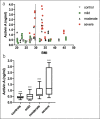Activin A Modulates Inflammation in Acute Pancreatitis and Strongly Predicts Severe Disease Independent of Body Mass Index
- PMID: 32358238
- PMCID: PMC7263641
- DOI: 10.14309/ctg.0000000000000152
Activin A Modulates Inflammation in Acute Pancreatitis and Strongly Predicts Severe Disease Independent of Body Mass Index
Abstract
Introduction: Acute pancreatitis (AP) is a healthcare challenge with considerable mortality. Treatment is limited to supportive care, highlighting the need to investigate disease drivers and prognostic markers. Activin A is an established mediator of inflammatory responses, and its serum levels correlate with AP severity. We hypothesized that activin A is independent of body mass index (BMI) and is a targetable promoter of the AP inflammatory response.
Methods: We assessed whether BMI and serum activin A levels are independent markers to determine disease severity in a cohort of patients with AP. To evaluate activin A inhibition as a therapeutic, we used a cerulein-induced murine model of AP and treated mice with activin A-specific neutralizing antibody or immunoglobulin G control, both before and during the development of AP. We measured the production and release of activin A by pancreas and macrophage cell lines and observed the activation of macrophages after activin A treatment.
Results: BMI and activin A independently predicted severe AP in patients. Inhibiting activin A in AP mice reduced disease severity and local immune cell infiltration. Inflammatory stimulation led to activin A production and release by pancreas cells but not by macrophages. Macrophages were activated by activin A, suggesting activin A might promote inflammation in the pancreas in response to injury.
Discussion: Activin A provides a promising therapeutic target to interrupt the cycle of inflammation and tissue damage in AP progression. Moreover, assessing activin A and BMI in patients on hospital admission could provide important predictive measures for screening patients likely to develop severe disease.
Conflict of interest statement
Figures





References
-
- Banks PA, Bollen TL, Dervenis C, et al. Classification of acute pancreatitis—2012: Revision of the Atlanta Classification and Definitions by International Consensus. Gut 2013;62(1):102–11. - PubMed
-
- Garg PK, Madan K, Pande GK, et al. Association of extent and infection of pancreatic necrosis with organ failure and death in acute necrotizing pancreatitis. Clin Gastroenterol Hepatol 2005;3(2):159–66. - PubMed
Publication types
MeSH terms
Substances
Grants and funding
LinkOut - more resources
Full Text Sources
Other Literature Sources
Medical

